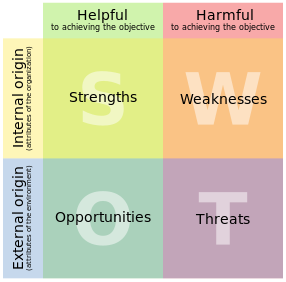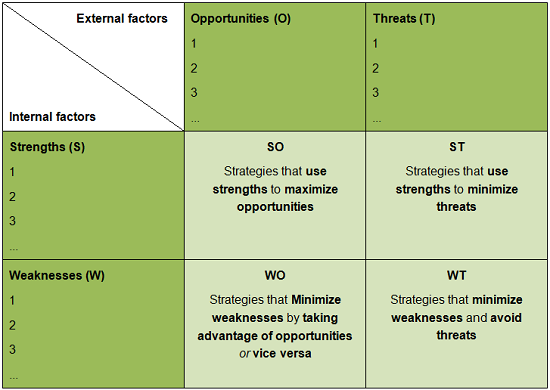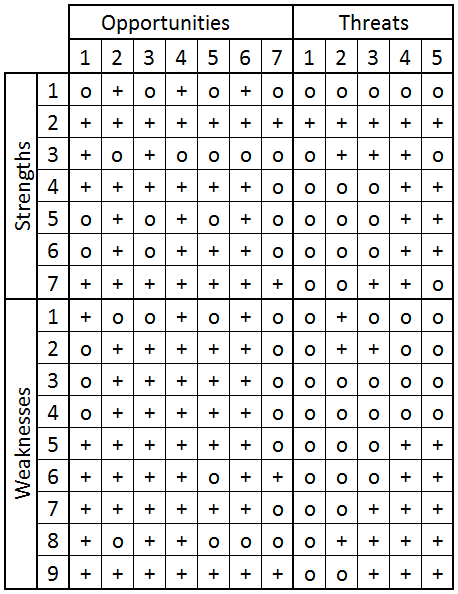SWOT analysis
Developed by Morten Lund
This article will discuss two different applications of SWOT analysis - the "conventional" and a variant called the TOWS Matrix, which utilises the inventory of SWOTs in a more systematic way than the conventional. The SWOT analysis is a tool that provides a basic framework for situation analysis. It generates lists or inventories of strengths, weaknesses, opportunities and threats which can be used when generating strategies [1]. The SWOT-factors are universal which makes the analysis applicable in many organisational contexts, but is also applicable for personal use in e.g. career planing [2] [3] [4]. In project and program management the SWOT analysis can be carried out in all phases of the life cycle in order to monitor and manage internal and external environments. In portfolio management the SWOT analysis can be used to identify new projects. There is no single guide or manual on how to perform a SWOT analysis - on the contrary many papers, books and articles have been issued describing, criticising and elaborating on the applications of the SWOT analysis [5] [6] [1] [7]. The criticism is often based upon the fact that it has a simple structure and does therefore, in itself, not provide a rigorous framework that ensures reliable inputs to strategic planing. An analysis can thus, if not carefully conducted, consist of poorly structured inventories containing very general or vaguely formulated factors that are inconsistent and hard to verify [1] [7]. These issues will be addressed with the aim of creating an awareness in the reader of the typical "pitfalls" when conducting a SWOT analysis or TOWS Matrix.
Contents |
The history of SWOT
Although there is no single inventor/author of the SWOT analysis, early versions are developed in Harvard Business School by George Albert Smith Jr. and C Roland Christiensen in the 1950s and 1960s [8]. The four factors that later became the Strengths, Weaknesses, Opportunities and Threats (SWOTs) were then called "opportunities" "risks" "environment" "problems of other industries". Another version was developed at Stanford University by Albert Humphrey which was based upon factors we know as SWOT today. The factors, represented by the acronym SOFT, were then: “What is good in the present is SATISFACTORY, good in the future is an OPPORTUNITY; bad in the present is a FAULT and bad in the future is a THREAT.” [4] The TOWS Matrix was authored in 1982 by Heinz Weihrich, Professor of Management at University of San Francisco [6].
Paramount issues to consider
Before launching into the SWOT analysis or the TOWS Matrix there are some issues, as mentioned in the introduction, to be aware of.
In order to obtain adequate and truthful information upon which solid strategies can be generated, all stakeholders of the project or program team have to be represented when the analysis is being conducted. This includes not only representatives on corporate level but on production level as well [1]. The worker "on the floor" could also possess viable and tangible insights which, if overseen, could have significant impact on the strategy and therefore also on the outcome of the project or the program itself. An opportune quality of the SWOT analysis is, when all stakeholders conduct the SWOT analysis together, the creation of a "common language" [9]. This does, on the other hand, also imply that a shared reflection takes place where the stakeholders decide on and adequately verify the proposed SWOTs in relation to the objectives of the project or program [1]. A task that has the potential of initiating challenges related "human behavioural" issues e.g. diverse agendas from the stakeholders and on which bases of power these agendas are enforced [10].
Different applications of SWOT analysis
Internal Factors
The strengths and weaknesses are internal factors representing the present environment of a system. This means that they are all factors the system is in control of. Often the internal factors can be found within these general areas: [2]
- Human resources - e.g. staff, volunteers and leaders
- Physical resources - e.g. production facilities and equipment
- Activities and processes - e.g. programs and systems you employ
- Past experiences
External Factors
The opportunities and threats are factors from the external environment which have the potential to influence a system in the future. The external factors can be found within the areas which are considered in the below mentioned analysis tools.
Porter's Five Forces [11]
- Rivalry among existing competitors
- Threat of new entrants
- Bargaining power of buyers
- Threat of substitute products or services
- Bargaining power of suppliers
PESTEL analysis [12]
- Political
- Economical
- Social
- Technological
- Environmental
- Legal
Conventional SWOT analysis
The conventional SWOT analysis is usually presented in a 2X2 matrix which generates four boxes of inventories - one for strengths, one for weaknesses, one for opportunities and one for threats, see figure 1 [13]
Figure 1
The analysis can be carried out in three steps [4]:
Step 1 Gather information about the present. These are the helpful strengths and the harmful weaknesses.
Step 2 Think of what might be in the future. These are the helpful opportunities and the harmful threats.
Step 3 Review the SWOT matrix with the aim of creating an action plan
The TOWS Matrix
The tows matrix is a framework that facilitates a systematic analysis by matching the external opportunities and threats with the internal strengths and weaknesses of an organisation [6].
The matrix in figure 4 (drawn with inspiration from [3]) contains, like the SWOT analysis, four boxes where the SWOTs are listed. There are however furthermore four boxes which are used for developing concrete strategies derived from matching the external factors with the internal factors. The four examples given here come from a TOWS Matrix applied to Volkswagen (VW) in the 1970's. [6]
- ST - Strategies that use strengths to minimize threats. Due to a devaluation of the Dollar in relation to the Deutsche Mark, the exchange rate rose thus increasing the prices for VW's American buyers. This gave other car manufacturers an competitive advantage. VW were strong in R&D and engineering as well having strong automation capabilities and therefore an efficient production. This meant that VW could cope with the unfavourable exchange rate and the their competitors by building an assembly plant in U.S.
- WO - Strategies that Minimize weaknesses by taking advantage of opportunities or vice versa. VW also faced the threat of rising salary costs in Germany. Attractive offers were given to build an assembly plant in U.S. which presented an opportunity VW could take advantage of. A weakness VW overcame was their reliance on the Beetle model. People were getting wealthier and demanded a greater variety of cars in with more options. The solution was the deployment of the building block principle which allowed VW to use the same parts in different cars on different price levels.
- SO - Strategies that use strengths to maximize opportunities. VW were still strong in R&D and engineering as well having an efficient production. This combined with attractive offers to build an assembly plant in U.S. also pointed towards doing so.
- WT - Strategies that minimize weaknesses and avoid threats. In the case of VW, the threats from loosing market share due to the unfavourable exchange rate into Dollars and the growing demand from the U.S. customers a WT strategy could have been to engage in a joint operation with Chrysler or American Motors. This did not happen because VW were able to overcome their weaknesses making them into strengths and exploiting the opportunities.
Figure 4
The inventories of internal and external factors can sometimes be extensive. Identifying the relationships between them can therefore be a complex process [6]. Figure 5 represents a model that can be used when doing so. The "+" indicates a match while the "o" indicates that there is no match.
Figure 5
References
- ↑ 1.0 1.1 1.2 1.3 1.4 [SWOT does not have to be recalled - it needs to be enhanced] http://www.westga.edu/~bquest/2000/swot1.html
- ↑ 2.0 2.1 [Assessing Community Needs and Resources » Section 14. SWOT Analysis: Strengths, Weaknesses, Opportunities, and Threats] http://ctb.ku.edu/en/table-of-contents/assessment/assessing-community-needs-and-resources/swot-analysis/main
- ↑ 3.0 3.1 [Using the TOWS Matrix Developing Strategic Options From an External-Internal Analysis] http://www.mindtools.com/pages/article/newSTR_89.htm
- ↑ 4.0 4.1 4.2 [SWOT analysis (TOWS matrix) Made Simple] https://rapidbi.com/swotanalysis/
- ↑ [Sepehr Ghazinoory , Mansoureh Abdi & Mandana Azadegan-Mehr (2011) Swot Methodology: A State-of-the-Art Review for the Past, A Framework for the Future, Journal of Business Economics and Management, 12:1, 24-48, DOI: 10.3846/16111699.2011.555358] http://dx.doi.org/10.3846/16111699.2011.555358
- ↑ 6.0 6.1 6.2 6.3 6.4 [Heinz Weihrich - The TOWS Matrix --- A Tool for Situational Analysis] http://www.usfca.edu/fac_staff/weihrichh/docs/tows.pdf
- ↑ 7.0 7.1 [Terry Hill and Roy Westbrook - SWOT Analysis: It's Time for a Product Recall] Long Range Planning, Vol. 30, No.1, pp. 46 to 52, 1997, Elsevier Science Ltd
- ↑ [History of SWOT Analysis] http://www.marketingteacher.com/history-of-swot-analysis/
- ↑ [sSWOT - A Sustainability SWOT] User's Guide, World Resources Institute, 2012
- ↑ [Josef Oehmen and Christian Thuesen, Alternative Perspectives (II) + (III): Standardization and Institutionalization of Project, Program and Portfolio Management] 42433: Advanced Engineering Project, Program and Portfolio Management, November 14, 2014
- ↑ [The Five Competitive Forces That Shape Strategy] https://hbr.org/2008/01/the-five-competitive-forces-that-shape-strategy
- ↑ [A Dictionary of Business and Management (5 ed.)] Oxford University Press 2009
- ↑ [A SWOT analysis, with its four elements in a 2×2 matrix.] http://en.wikipedia.org/wiki/SWOT_analysis


